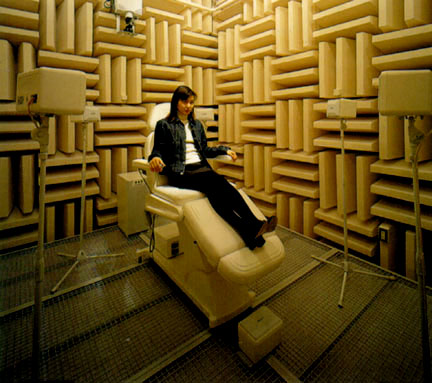
Seiko Mikami "World,
Membrane and the Dismembered Body" [1-1]
Ver1.1 ...| Ver1.2.. | Ver2.0... | TEXT... |
Premiere version 1.0 : the permanent collection of ICC-Inter Communication Center, Tokyo, 1997 April - .

(1)Throughout
This project takes place in an anechoic room and uses a computer and
various measuring devices to gauge the body's internal sounds. The sounds
of the body's internal organs are amplified and transformed within this
space to present a "perception-driven architecture." With the exhibition
visitor's ear serving as the interface to the audible noises that his/her
own body emits, feedback is produced. In addition, the sounds of the heart,
lungs, and pulse beat that are numericized by the computer act as parameters
to form a continuously transforming 3-D polygon mesh expressing sounds
and images in the anechoic room. Therein , two situations are effected
in real time: the slight sounds produced by the body itself reverberate
the body's internal membranes, and the transfigured resonance of that sound
is amplified in the anechoic room; a time-lag exists in this process. Neither
the body nor the environment is cast as the object of representation; rather,
the "ear" that intervenes signifies a kind of inter-medium that serves
as the perceptual link, or code, between the acoustic sense and the space
of the room. This in between "ear" is the abstract expression of the work's
claim that "the ear is not merely a thing that hears; the eye is not merely
a thing that sees".
Here, the ear/acoustic sense, a fragment of the exhibition visitor's
body, serves as a circuit for unfixed data--such as the heart tone, a psychological
affect, that is employed according to the second-to-second changes in mental
images. Thus, a fundamental gap is born between the body's response, when
the heart is made to palpitate and undergo change in the anechoic room,
and its result as expressed in the movement of sounds emitted from the
body. When the body's heart beat is thrown off course by an intervention
from the outside, the desire arises to try to control the sounds that the
body emits. A gap occurs between this event and the resulting desire; thus,
the visitor is overcome by the feeling that a part of his corporeality
is under erasure. The visitor exists as abstract data, only his perceptual
sense is aroused. The visitor is made conscious of the disappearance of
the physical contours of his subjectivity and thereby experiences being
turned into a fragmented body.
(2)The Body's Internal Noise and the Anechoic Room
The anechoic room is a special space where sound does not reverberate.
Yet
it is not silence but sound that exists in this space; that of the
body's own internal noise. If the visitor remains in the anechoic room
for a long time he is given the illusion of being dominated by the sounds
of the body's pulse beat and membranes. In listening to the sounds that
reverberate against the body's membranes--sounds generated by heart beat,
lungs, pulse beat and the rumblings of the stomach--the visitor realizes:
"I myself produce noise." One could say that the heart beat itself is the
most fundamental form of self-expression.
In creating this computer program I attempted to address the effect
of numericized processes on perception and the body, and in so doing I
have once again been reminded of the widespread ambiguities inherent in
the perceptual world. The parameters of the heart beat are always shifting
and because this program is based on each visitor's "conscious" state,
the visitor's expectations are repeatedly broken down during the experience.
With regard to the body's acoustic sense, the body's internal noise is
something that exists prior to the body itself . The act of forming one's
self is instigated by listening to one's own internal sounds with one's
own ears. The ears mediate the space that exists between the self and the
body. The visitor's presence in the anechoic room can be considered analogous
to the way the heart exists within the body; yet, in this instance, the
visitor does not have the visual stimulus of being able to see the body's
interior. It is an acoustic experience more than anything else, one in
which the visitor becomes more than usually aware of the ear. Ultimately,
the visitor has the impression of being inside a huge ear.
photo:Takashi Ohtaka+ICC